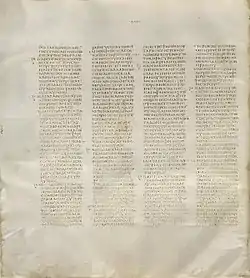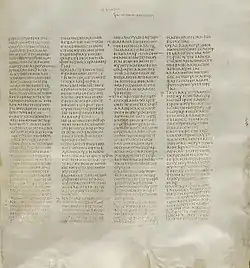| Matthew 8 | |
|---|---|
 Matthew 7:27–8:28 on Codex Sinaiticus (AD 330–60). | |
| Book | Gospel of Matthew |
| Category | Gospel |
| Christian Bible part | New Testament |
| Order in the Christian part | 1 |
| Gospel of Matthew |
|---|
|
Chapters |
Matthew 8 is the eighth chapter of the Gospel of Matthew in the New Testament and continues the narrative about Jesus' ministry in Galilee previously described in Matthew 4:23–25. It follows on from the Sermon on the Mount, noting in its opening verse that Jesus had come down from the mountain where he had been teaching. There is a renewed focus in this chapter on Jesus' ministry of healing.
Text

The original text was written in Koine Greek. This chapter is divided into 34 verses.
Textual witnesses
Some early manuscripts containing the text of this chapter are:
- Codex Vaticanus (AD 325–50)
- Codex Sinaiticus (330–60)
- Codex Bezae (c. 400)
- Codex Washingtonianus (c. 400)
- Codex Ephraemi Rescriptus (c. 450; complete)
Structure
.JPG.webp)
This chapter can be grouped (with cross references to parallel texts in the other canonical gospels):
- Matthew 8:1–4 = Jesus cleansing a leper (Mark 1:40–45; Luke 13:1–23)
- Matthew 8:5–13 = Healing the centurion's servant (Luke 7:1–10; John 4:46–53)
- Matthew 8:14–15 = Healing the mother of Peter's wife (Mark 1:29–31; Luke 4:38–39)
- Matthew 8:16–17 = Jesus exorcising at sunset (Mark 1:32–34; Luke 4:40–41)
- Matthew 8:18–20 = The cost of discipleship: "The foxes have holes" (Luke 9:57–58)
- Matthew 8:21–22 = "Let the dead bury their own dead" (Luke 9:59–62)
- Matthew 8:23–27 = Calming the storm (Mark 4:35–41; Luke 8:22–25)
- Matthew 8:28–34 = Exorcism of the Gerasene or Gergesene demoniacs (Mark 5:1–20; Luke 8:26–39)
Analysis
E. H. Plumptre, in Anglican bishop Charles Ellicott's Commentary for English Readers, commented that the events reported "are common to St. Mark and St. Luke, but are not narrated … in the same order".[1] Free Church minister William Robertson Nicoll suggested that "this collection is not arranged in chronological order. The connection is topical, not temporal." In his opinion these stories "are an integral part of the self-revelation of Jesus by word and deed; they are demonstrations not merely of His power, but above all, of His spirit".[2]
New Testament scholar Dale Allison notes that these "merciful deeds" performed by Jesus, along with those recorded in chapter 9, are all undertaken for the benefit of "people from the margins of Jewish society or without status".[3] Henry Alford describes these deeds as a "solemn procession of miracles", whose record confirms "the authority with which our Lord had spoken".[4]
The Jerusalem Bible notes that the ten miracles recorded in chapters 8 and 9 demonstrate the power of Jesus over nature, sickness, death and devils.[5]
See also
References
- ↑ Plumptre, E. H., Ellicott's Commentary for English Readers on Matthew 8, accessed 21 December 2016
- ↑ Nicoll, W. R., Expositor's Greek Testament on Matthew 8, accessed 26 December 2016
- ↑ Allison, D. Jr., "57. Matthew" in Barton, J. and Muddiman, J. (2001), The Oxford Bible Commentary, p. 857
- ↑ Alford, H., Greek Testament Critical Exegetical Commentary - Alford on Matthew 8, accessed 17 November 2022
- ↑ Jerusalem Bible (1966), sub-title and footnote a at Matthew 8:1, 3
External links
- Matthew 8 King James Bible - Wikisource
- English Translation with Parallel Latin Vulgate
- Online Bible at GospelHall.org (ESV, KJV, Darby, American Standard Version, Bible in Basic English)
- Multiple bible versions at Bible Gateway (NKJV, NIV, NRSV etc.)
| Preceded by Matthew 7 |
Chapters of the New Testament Gospel of Matthew |
Succeeded by Matthew 9 |